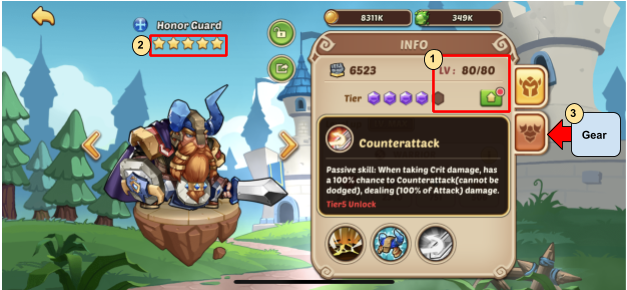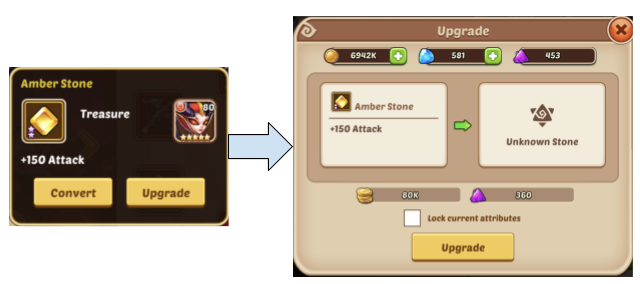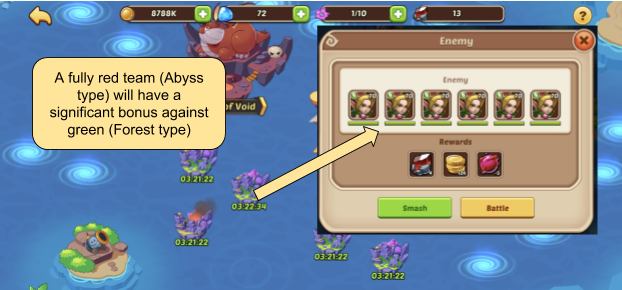How Idle Heroes made $100M in a Year
This post is by Joseph Kim, Chief Product Officer at SEGA Networks (SEGA’s mobile division), cross-posted from his mobile gaming blog at GameMakers.com.
In June of 2016, little known Chinese publisher DroidHang Games (aka “DH Games”) launched Idle Heroes, an auto-battle RPG with very heavy Asian metagame design influence. Although seemingly unremarkable at first launch, the game has steadily grown its download and revenue. Today the game sits on an estimated $70MM in accumulated net revenue.
Since Idle Heroes launched in June of 2016, it has grown its revenues rapidly across several key markets racking up over $71 million in net revenues and with around 12 million installs. Very impressive, considering that the initial average daily rev during first 3 months from launch totalled $1,075 compared to $264,663 in January of 2018
How did such a small and, otherwise, unheralded Chinese publisher achieve success with their game even outside of China?
The “Meta Wrap” Strategy
The developers of Idle Heroes deployed a fairly common strategy at the time employed by games such as, most famously, Star Wars: Galaxy of Heroes (read: Galaxy of Heroes - Full Deconstruction of EA’s Death Star). These games copied the core metagame systems design popularized by Heroes Charge (who literally ripped Lilith’s DOTA Legends) but wrapped the metasystems design around a different core gameplay system.
What is Idle About Idle Heroes?
Beyond the Meta Wrap strategy, however, Idle Heroes went one step further. The game took a key characteristic from idle games and integrated idle mechanics into the game’s core loop. Notice I did not call the game an idle game but rather mentioned that it borrowed an idle mechanic.
From a gameplay perspective, the game plays nothing like the other idle games in the category which begs the question: Is Idle Heroes an idle game? In my opinion, the answer is no. Then why is the game called Idle Heroes? To be honest, I’m not sure. Maybe marketing? It’s not 100% clear. However, whether you define games by core gameplay or by systems or characteristics, it’s a fairly difficult argument to make that Idle Heroes is an idle game. Hence, not so idle.
What Is Idle Heroes?
Let’s go back to the high-level overview of the game here below:
That’s basically it. Overall, a simple strategy with good execution and likely good timing. Let’s look at each of these three core pillars in turn.
Gameplay
By doing turn-based autobattle, the game differences meaningfully from Heroes Charge type gameplay (exactly as Star Wars: Galaxy of Heroes also did). Further, a turn-based battle is easy to auto (important for elder game players) and relatively interesting to watch.
Idle Heroes offers simplified automated gameplay bundeled with elaborate RPG mechanics
Gameplay progress focuses on character upgrading and collection. To get further in the campaign critically depends on this.
Core Loop
Idle progress collection refers to the practice of idle games in which players make continuous progress in the game through soft currency accumulation even when not playing. A strong advantage of this design element is the positive feeling players receive from the rewards they just received and from the progress they made while not actively engaged in the game.
In Idle Heroes, this idle progress collection mechanic is inserted into the core loop of the game (rather than an app open as other idle games). By doing so, the mechanic helps motivate players to increase activity and retention for the core loop actions.
Simplified diagram of Idle Heroes core loop
Most idle games place the idle progress collection upon the first launch of the application. However, Idle Heroes places the collection within the core loop of the game within the campaign battle screen.
Both of these scenarios are depicted below:
Example idle progress collection in AdVenture Capitalist vs. Idle Heroes
Core loop progress critically depends on utilizing idle progress collection as well as usage of a large number of metasystems built into the game.
Metagame
The core metagame features were clearly inspired by Heroes Charge (which was itself inspired by the China-only hit DOTA Legends). The list below lists an overview of the core metagame features in Idle Heroes.
Character Upgrades (inspired by Heroes Charge)
Variation of Heroes Charge model, slightly simpler model. Tier system. No notion of quality. No skill upgrading.Equipment System (inspired by Heroes Charge) Simpler item combination variation of Heroes Charge model but includes a separate Blacksmith. Interesting locked slot system.
Tavern (inspired by Asian MMOs) Character mission system requiring different character prerequisites to gain rewards.
Celestial Island (inspired by Heroes Charge) Variation of Advanced Instances, basically having multiple PVE modes that encourage using different characters.
Summon Circle (inspired by Heroes Charge) Free and premium gacha summon, similar to many games including Heroes Charge
Arena (inspired by Heroes Charge) Easier to farm variation of Heroes Charge. No cool down. Skip battle option.
Brave (inspired by Heroes Charge) Trial Variation of Crusade (Survival mode)
Tower of Oblivion (inspired by Summoners War) Non-timed version of Summoners War’s Trial of Ascension
Blacksmith (inspired by Heroes Charge) Variation on Heroes Charge. Ability to upgrade gear items into better gear items. A separate Blacksmith area is used instead of integrated within the character UI.
Casino (inspired by Game of War) Common and Super Casino. Random drops based on wheel spins requires separate Chip currency to spin.
Guild (inspired by Heroes Charge) Better UX version of Heroes Charge with more farming features.
VIP (inspired by Heroes Charge) 13 levels of VIP. Daily bonus, hero slots, hero quest, and many other bonuses depending on the amount of gems purchased.
Monster (inspired by Game of War and Asian MMOs) Acts almost like an additional party member during battle. Deals damage, gives bonuses and can activate some skills like healing.
Similar to Heroes Charge-type games, there are a lot of metasystems! To some degree, it’s surprising that this level of metagame complexity has been relatively well accepted by a Western audience. Traditionally, Chinese-style metasystems have been thought to be too complex and involved for Western players. However, with Idle Heroes and other games like Summoners War and Star Wars: Galaxy of Heroes, we are increasingly seeing greater acceptance of complex metagame design for Western audiences.
It’s also surprising how the game brands itself as an idle game. Many view idle gamers as typically more casual rather than hardcore in nature. On the face of it, this may seem like a potential audience mismatch between casual idle game players and a game with complex metagame systems. However, this particular combination seems to have been a very good match.
While copying most of the base metasystems from Heroes Charge-type games, Idle Heroes does make meaningful changes and improvements to those systems. The most interesting parts of the metagame include the way Idle Heroes has designed their Character Upgrade system.
Let’s me explain that in more detail next...
Character Upgrade System:
Of all the metasystems, the game really shines when it comes to its extremely deep character upgrade system.
Character System and Upgrading:
First of all, gameplay requires 6 active playable characters each of which has a specific color type (called “Factions”). The color type system follows a typical battle triangle (rocks, scissors, paper) system as shown below:
Idle Heroes employs traditional color-coded faction system
Characters in the game are upgraded along a number of key areas:
Stars: Characters are upgradable up to 10 stars and each star increases base stats and abilities. The higher the base number of stars of a character the better it is. For example, a character that starts at five stars is better than a character that starts at three stars and is upgraded to five stars. Star upgrading is based on a fairly typical sharded gacha fusion system. More detail below.
Level: Characters are leveled up via gold (primary soft currency) and purple orbs. The purple orbs are fairly difficult to acquire after early game. Players will get pinched requiring hard currency spend or massive grind to level up even the base team of six characters not to mention multiple teams.
Equipment: Characters can equip up to six items. Equipment items give bonuses primarily to HP and attack. These bonuses apply both generally and against specific classes and factions. More info on this system later in this post.
The Character Upgrade Screen as shown below:
1. Stars (and Awakening):
Characters can upgrade up to 10 stars. Star upgrading requires the fusion (or sacrifice) of other characters of lesser stars as well as purple orbs. Characters to be sacrificed are acquired via gacha and purple orbs are acquired via the main campaign mode and some of the metasystems in the game.
In this game, Awakening refers to the upgrading of stars from the 6th star on. The awakening system does not upgrade in parallel as in other games.
As an example of star upgrading, as seen below, getting a 9-star Ormus to 10 stars requires:
Two 5-star Ormus heroes
One 6-star hero (any)
One 9-star hero (any)
Stars are displayed on the character as either:
First 5 stars = 1-5 yellow stars
Next 4 stars (stars 6-9) = 1-4 purple/pink stars
10th star = 1 orange star
example of Star upgrading requirements
2. Leveling:
Level-ups increase the four base stats of each hero:
Health
Attack
Armor
Speed
Leveling increases characters base stats
In addition, increasing levels unlocks up to four total skills in addition to leveling up skills.
Additional skills are unlocked and upgraded with level ups. Level up tiers, on the other hand, are gated by Evolutions.
3. Equipment System.
The Equipment System in the game is a variation of the Heroes Charge model with a few key differences.
Screenshot of Character Equipment Screen
Characters have six equipment slots (five open slots and one locked, fixed slot; see image above)
Equipment primarily gives bonuses to HP (Hero health) and various forms of attack and damage
The five open slots each have a type and are acquired via various PVE modes and the Marketplace.
The locked slot unlocks after reaching level 40. The locked slot item holds an upgradable “stone” item. This stone is specific to each hero and cannot be transferred to other heroes.
Stone Equipment Upgrading
This very interesting twist on equipment systems serves as an additional primary soft currency sink (Gold) as well as requiring an additional resource type called Purple Dust. Further, it’s very similar to the Summoners War equipment upgrade system (rune system) in that it introduces an element of RNG (random number generation) to the upgrade flow.
In the image below, you can see two choices for upgrading the stone equipment item: 1. “Convert” or 2. “Upgrade”. Upgrading will increase the bonus amount received upon paying the upgrade cost which is shown in the modal on the right. Convert refers to changing the type of bonus that the stone gives. Every time a stone is upgraded the RNG portion of the upgrade involves randomly determining the bonus type.
Overview of the Stone upgrade flow
Character Upgrade Overview:
To summarize it all, here's an overview of the Character Upgrade flow is shown below (thanks to Jeff Witt!):
source: Jeff Witt
Character Diversity Motivation:
One of the biggest challenges for any character+gacha-based game is the problem of motivating players to collect and upgrade a diverse roster. How do you incentivize players to want a lot of characters and how do you motivate them to upgrade a large number of them?
Idle Heroes does this particularly well with many of the systems and PVE modes integrated into the game as we’ll see below.
In the game, different bonuses (called “Faction Auras”) are gained depending on the roster types deployed. These bonuses vary depending on the composition of color types (“factions”) in the team roster.
As an example, “Color Mixing” will give a bonus if a hero from each color is used in the team:
The “Good vs. Evil” aura activates when 3 dark (purple) and 3 light (orange) heroes are used in a team:
In the Celestial Island PVE mode, different enemy teams have different color combinations making them weak to specific types of teams:
Example of All Green-type Enemies in Celestial Island - Motivates building a Red Team
In the Tower of Oblivion PVE mode, similar to Celestial Island, enemy team compositions encourage the player to mix up and upgrade their team character rosters more widely. Faction auras and battle triangle bonuses are strong enough to motivate players to create strong teams that can take advantage of those bonuses.
In the example below the enemy team is comprised of a single color type.
Even further, one of the Arena modes requires 3 full teams (thereby motivating hero collection and diversity of upgrading):
Arena Mode That Requires Three Full Character Teams
Monetization
To get a deeper understanding of the monetization and character upgrade systems in Idle Heroes, I spoke to expert systems designer Jeff Witt. Jeff was a founder of Funzio and lead systems designer in top grossing games including Modern War.
I asked Jeff the following questions (with key takeaways also listed below):
Is Idle Heroes an idle game? [0:00]
The developers would want players to think it is
Of the 7 or 8 gameplay systems in Idle Heroes only 1 or 2 are idle influenced
The majority of systems are more “stat check” that is more consistent with RPGs like Heroes Charge
What is your general opinion of Idle Heroes vs. other idle games? [1:36]
Likes Idle Heroes better because it feels more like an RPG than other idle RPGs (such as Tap Titans, Nonstop Knight, etc.)
Strategy for idle RPGs is very singular more focused on when to prestige, Idle Heroes is more strategically diverse
Is the character upgrade system the best part of Idle Heroes? [2:21]
It’s the best part of the elder game. It gives players a direct pathway to getting stronger. It also makes all of the systems in the game continue to be relevant.
Many RPGs have a problem of keeping gacha relevant. Value of gacha typically plummets once a team is optimized. In this game, every single thing you get in gacha can be used down the road.
Based on the design, Idle Heroes can be very lucrative with their sales. They have a very deep system which is part of why they are doing so well.
Can you breakdown the character upgrade system? [4:33]
Stars cap max level of character. Upgrade characters by gold and promotion stones. By 5 stars, need to sacrifice other characters (gacha fusion).
If you map out going from 5 stars to 10 stars, may require 400-500 4 star characters. It’s a super deep system.
Idle Heroes does a great job of making clear what the upgrade pathway is.
How would you characterize the monetization potential of this game relative to other idle games? [6:23]
In comparison to other idle RPGs, it’s clearly superior
Leaving depth of game aside, the advantage is that the monetization system cannot be undermined by prestige. When you play Tap Titans or Nonstop Knight you can overcome challenges by prestiging, with Idle Heroes, you don’t have that system. There are more stat checks in the game and to get better in those stats you need to engage with the metasystems and monetize because the grind is so painful. Hence, this game monetizes far better.
How would you characterize the monetization potential of this game relative to other RPGs like Summoners War or Star Wars: Galaxy of Heroes? [7:45]
I would believe that Idle Heroes could monetize more per player than Summoners War or Star Wars: Galaxy of Heroes. The depth that Idle Heroes has attained with all of its metasystems just allows the game to give more value to the player for the dollar.
Summoners War has a fair amount of depth, not as much as Idle Heroes, but their sales packages just aren’t as lucrative. Meaning that they may be monetizing less per player but likely monetizing more players. Star Wars: Galaxy of Heroes likely has the most paying players, but both games lack the depth of Idle Heroes.
Heroic Success from Humble Beginnings
Considering that DH Games had no previous success in the genre or a powerful IP to drive installs, they have achieved fairly significant success in Idle Heroes. The success, in our opinion, is due to three key strategies:
Meta Wrap Strategy: Employing the Meta Wrap strategy using Heroes Charge-type metasystems design and differentiated core gameplay.
Idle Games Integration: Integrating characteristics from idle games, in particular, idle progress to strengthen the core loop retention
Character System: Implementing an extremely well-designed character upgrade and collection system. In particular, the game employs an extremely deep monetization model that enables the game to give a lot of rewards and extremely granular upgrade progress. Also, the game creates strong incentives to collect and upgrade many characters through their gacha system.
We at Deconstructor of Fun strongly consider Idle Heroes to be a very good game for any professional F2P game designer to study for the reasons above. Further, I personally expect the three key strategies above to be employed and further expanded and articulated in future hit F2P mobile titles.























